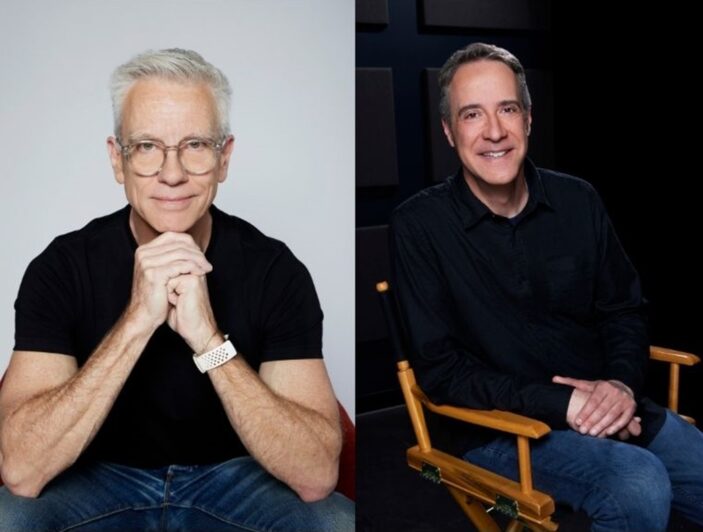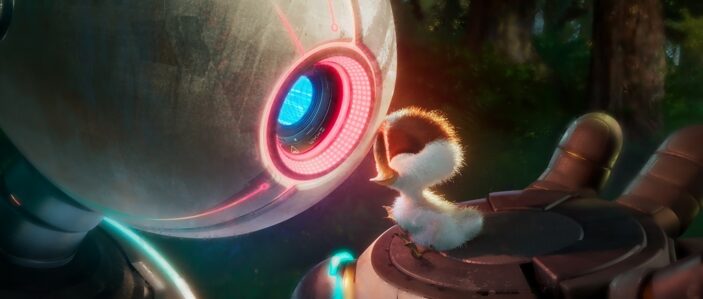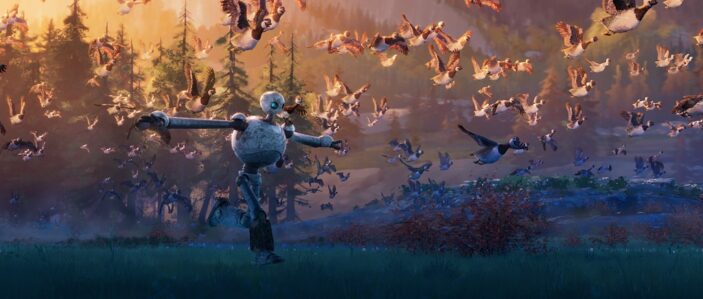
From DreamWorks Animation comes a new adaptation of a literary sensation, Peter Brown’s beloved, award-winning, #1 New York Times bestseller, The Wild Robot. The epic adventure follows the journey of a robot—ROZZUM unit 7134, “Roz” for short — that is shipwrecked on an uninhabited island and must learn to adapt to the harsh surroundings, gradually building relationships with the animals on the island and becoming the adoptive parent of an orphaned gosling.
A powerful story about the discovery of self, a thrilling examination of the bridge between technology and nature and a moving exploration of what it means to be alive and connected to all living things, The Wild Robot is written and directed by three-time Oscar nominee Chris Sanders and is produced by Jeff Hermann.
As the film’s latest, full-length trailer arrives online ahead of its theatrical release in September, Peter Gray spoke with both Chris and Jeff about their love of the animated medium, why Lupita Nyong’o was their first choice to lead the film, and what sequences never fail to make them cry.
Chris, this is your first solo animated directing venture after co-directing Lilo & Stitch, The Croods and How To Train Your Dragon, but you have experience with Call of the Wild. Is there a different approach in tackling animation on your own?
Chris Sanders: I think I felt less comfortable because I took time off (laughs). So, don’t take time off! But you collaborate with so many people that it didn’t feel super different. I do love collaborating with a co-director, because that collaborative process is why these (movies) work. I had an extraordinary Head of Story, and an editor, so I felt just as at home and safe as I did with all those other movies.
Jeff, you have an animation background. I’m going to quickly do a shout out to Sinbad: Legend of the Seven Seas, because I believe you were a Production Supervisor on that?
Jeff Hermann: My goodness, yes. You did some digging.
I think that film is so underrated, and Michelle Pfeiffer’s voice work is immaculate.
Jeff Hermann: Oh, thank you.
Where did that love of the medium originate for you?
Jeff Hermann: One of my earliest movie-going experiences that I can recall was Disney’s Pinocchio at a drive-in. I think I was 3 or 4-years-old, and I just was enamoured with the visuals and the artistry of that film. From that moment on I just had a love of animation. There was a brief time in my life that I entertained being an artist. I drew all the time. But once I got into college, I was taking Art and Film Production courses, and, for whatever reason, I leaned more into (the latter). I just wanted to be a part of every facet of the filmmaking process. That was where I switched gears. I always, always wanted to be a part of animation.

It feels like animation just attracts immense talent. Here you have Lupita Nyong’o, Pedro Pascal, Mark Hamill, Catherine O’Hara…were they people you specifically envisioned? Or was it more a case of being genuinely surprised when they were presented?
Chris Sanders: You launch off the characters. Roz (Lupita’s character) was the most interesting one, in that it’s not the most obvious what you want to do with them when you read the book and look at the character. You make a choice in what character you want to create. Pedro is a fox, and he does foxy things (laughs), and he has that clever, impish appeal going on. Roz, to a degree, is unwritten. The journey in finding Roz’s voice was that we went to Lupita first and foremost, because she’s such an amazing talent. She has an incredible voice, but, quite frankly, she’s an incredible actor. She has an incredible work ethic, she’s very inventive, and she’s a writer in her own right, so casting her was really just the beginning of finding and creating the character.
Being based on a novel, do you find pressure in streamlining the story as it’s two books? Do you keep things out of the novel sequel in the hopes that this film itself earns a sequel? Or do you blend narrative elements of both?
Chris Sanders: Oh, I see what you’re saying. We had a discussion about that. Do we try and wrap everything up in this one movie knowing there are two books, and actually a third being published? And that was something we spoke about with the studio. We asked if this was going to be something finite and we end this in the same way as the book.
Jeff Hermann: I think what was so great about what Chris did is that (this film) honours the book and how it ends, so if this was the only movie we ever made of this story you would feel satisfied.

With the animation itself, and I’ll put this to both of you, is there a choice in what particular style is chosen? We obviously see so many examples of animation now. What’s that conversation like in how you want this film to look? Or do you take direct inspiration from the novelisation?
Chris Sanders: That’s one of the big stories of the making of this movie, actually. Built into this story is a piece of technology that’s lost in the wilderness. First and foremost, we needed there to be a tangible feeling of a robot that is in the wrong place. We want the audience to be lost in that same wild place. One of the more interesting things of the production is that DreamWorks were at a point where they had begun to successfully depart from that standard CG-look that we had settled into.
I would say from the very beginning of that CG technology arriving we’ve been trying to get away from it. We felt obligated to step away from that warm, analogue, hand-made look that gave those first animated films their heart and soul. We were always trying to get back to that. It became more important than ever with Wild Robot to be convinced that we were in a forest. We asked our artists how far can we push that analogue look that had so successfully been created for Puss In Boots: The Last Wish.
I’m fully prepared for the fact that this movie will probably make me cry, going off the trailer. Animation seems to have a way of doing that. I wanted to ask both of you if there’s an animated film or sequence that is guaranteed to make you emotional?
Jeff Hermann: For me, it’s the sequence in Dumbo where he goes to visit his mother, who’s locked up for protecting him. They can’t really see each other and all they can do is touch trunks, and she just cradles him in her trunk. Gets me every time.
Chris Sanders: That’s a good one. Certainly, for me, I think Linus’ speech at the end of Charlie Brown’s Christmas is just so simple and so vulnerable.
The Wild Robot is screening in Australian theatres from September 19th, 2024.
